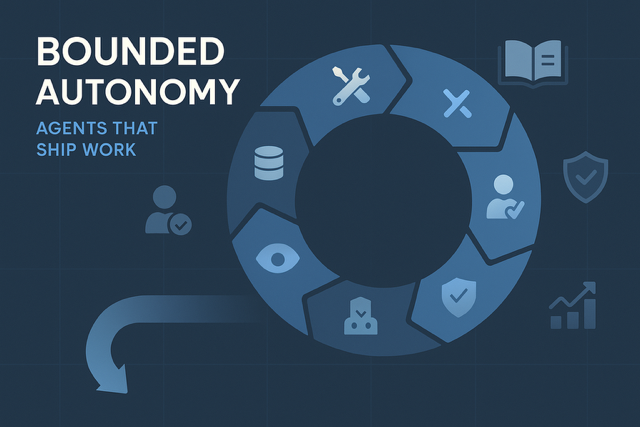
Thesis in one line: Copilots accelerate people; agents complete multi-step work. The deployments that win constrain autonomy, instrument every step, and define crisp human handoffs. Treat agents like workflow participants with SLAs, not magic.
Why agents and why now?
The first wave of AI made individuals faster at drafting, summarizing, and searching. Real operational value, though, tends to be trapped in messy handoffs across systems and teams. Agents address that by planning, calling tools, and finishing tasks end-to-end under supervision. In practice, bounded autonomy; tight scopes, explicit policies, and observable behavior, turns promise into dependable throughput.
Where agents fit (and where they don’t)
Across organizations I’ve led or advised or observed, agents shine on multi-step, tool-heavy, high-volume tasks with clear success criteria. Customer operations benefit from automated triage, entitlement checks, and CRM updates; finance teams offload invoice matching and reconciliations; supply chains manage exceptions and send structured supplier outreach; SREs run safe, read-only runbooks. On the other hand, ambiguous, high-stakes decisions that set customer terms (credit, pricing, eligibility) stay human-approved, with the agent preparing evidence and a recommended action. A useful test: would you hand this to a new hire with a precise checklist?
The enterprise agent in seven parts
A production-grade agent is seven cooperating components. Planner interleaves reasoning and acting (plan → act → observe → update) instead of jumping straight to output. Tools are whitelisted, strongly typed, rate-limited, and spend-guarded so “tool use” behaves deterministically. Retrieval & context, memory, policy checks, observability, and human-in-the-loop (HIL) complete the stack and make the system auditable.
This model turns black-box intelligence into something operations can run. The planner chooses the next step; tools do bounded work; policies enforce permissions and data hygiene. Observability streams traces, inputs/outputs, and costs; HIL rules define when to escalate. When any pillar is missing, reliability suffers.
Safety and security: design for failure
Agents mix LLM behavior with tool execution, so the threat surface includes both untrusted inputs and well-intentioned tools doing the wrong thing perfectly. Teams have had success with containment first: sandboxed tools, scoped credentials, and explicit allow/deny lists. Add input hygiene (strip active content, canonicalize text), adversarial evaluations (prompt-injection patterns, tainted retrieval), and incident playbooks with rollback rehearsed. Security isn’t a feature; it’s an operating discipline with drills and evidence.
Four patterns that keep paying off
1) Support triage & resolution drafting.
Agents classify cases, check entitlements, locate policy answers, update CRM, and schedule follow-ups. Guardrails include source-grounding, tone filters, HIL for refunds or legal claims, fatigue caps, and bias checks on routing. Results show fewer escalations and faster cycle times on common intents.
2) Product Software runbook execution.
Agents read logs, correlate known errors, draft remediation steps, open change requests, and prepare rollback plans. Production stays read-only; any change needs human approval; tool calls are rate-limited; incidents feed new tests into the eval suite. On-call gets cleaner and time-to-mitigation drops.
3) Supply-chain exception handling.
Agents detect late shipments, propose reorder quantities within thresholds, and notify suppliers with context. Hard caps and tolerance windows prevent overreach; order creation requires dual-control approvals; a rollback macro reverses bad proposals. The pattern scales across categories once thresholds and evidence trails are in place.
Operate agents like mission-critical workflows
The metrics that matter mirror any operational service. Task success rate (end-to-end without human correction), handoff rate with reasons (safety, uncertainty, policy, cost), cycle time, cost per task (model + tool/API + review minutes), incident rate/MTTR, and operator trust. For customer-facing flows, track CSAT/NPS on assisted interactions. Time-to-first demo is nice; unit economics over a 30-day window is decisive.
A unit-economics dashboard is non-negotiable. Tokens spend and API costs are visible, but human review minutes dominate early. Step budgets and smarter tool selection drive cost down as reliability improves. This is how teams avoid the “cool demo, costly operations” trap.
A 30/60/90 plan that moves from demo to dependable
Days 0–30: Prove the loop, bound the risk.
Pick one high-volume task tied to a single system of record. Stand up the seven-part runtime with two whitelisted tools and a strict step budget (for example, ≤12 actions per task). Build a golden task set; run daily regressions; gate any write action behind HIL. Shadow users to collect traces before exposing the agent broadly.
Days 31–60: From functioning to trustworthy.
Add one adjacent task and two more tools while keeping the same guardrails. Instrument cost and latency end-to-end; publish a per-task unit-economics view for leaders and operators. Introduce adversarial tests (tricky inputs, tainted retrieval), fix anything that breaks, and capture structured human feedback (approve/correct/reject + reason). Draft an incident playbook with severity levels, on-call, and rollback steps.
Days 61–90: Prove value and resilience.
Enable assisted execution for a subset of users (opt-in), with HIL and rollback. Report a weekly value-and-risk scorecard: success, handoffs, cycle time, cost per task, incidents, and near-misses. Run a controlled experiment (A/B or stepped rollout) to quantify throughput/quality impact. Decide to scale, hold, or halt based on both business results and residual risk.
Governance that doesn’t slow you down
Lightweight governance travels with the work, not against it. A use-case register names purpose, tools, data, risk class, HIL rules, and owners; one page that defuses audit friction later. For anything customer-facing or rights/safety-impacting, raise the floor: HIL required, eval suite in CI, post-deployment monitoring, and quarterly incident drills. Align controls to recognized risk-management frameworks so evidence is reusable across teams and audits.
Common pitfalls (and simple fixes)
Unbounded autonomy guarantees surprises. Fix with tool whitelists, permission scopes, and step budgets. No crisp finish line yields vague wins; write success criteria as if QA had to score the output. Treating guardrails as one-and-done misses a moving target; keep red-teaming and regression evergreen. Measuring demos, not operations hide cost and risk; insist on success, handoffs, cost, incidents, and customer outcomes from day one.
Bottom line
Agents are ready for real work when designed for reality. Bounded autonomy, observable behavior, human judgment where it matters, and relentless measurement turn pilots into durable throughput and quality. Treated like teammates with SLAs and accountability, agents repay the trust with fewer escalations and more consistent outcomes. That’s how teams graduate from prototypes to production; without betting the business on unchecked autonomy.




